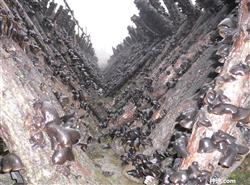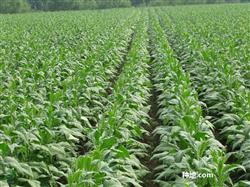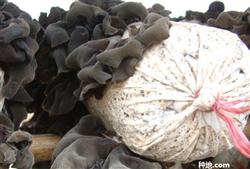How to cultivate black fungus?

How to cultivate black fungus? Please guide the fruiting body of Auricularia auricula to be solitary or petal-shaped, glial, translucent, concave, often bluish brown on the back, fluffy short hair, ventral smooth, veined wrinkles, reddish brown. The fruit body is 6-12 cm in diameter, 0.8-1.2 mm thick, and the foam rate is 8-22 times. From the back of the fruiting body, they are pilose layer, dense layer, subdense upper layer, middle layer, subdense lower layer, and fruiting layer. Nutrition: cellulose and lignin are the main sources of nutrition. When the mycelium of Auricularia auricula decomposes and ingests nutrients, it can continuously secrete a variety of enzymes to decompose cellulose, lignin and starch. In addition, glucose, maltose, sucrose and other sugars and calcium, phosphorus, iron, potassium, magnesium and other inorganic salts. Moisture: the water content of the culture medium is 60-70%, and the relative humidity of the air during the fruiting body growth stage is 85-95% and 80%. Temperature: Auricularia auricula belongs to medium temperature type, the hyphae are 6-36 degrees, 20-30 degrees are the most suitable, and above 38 degrees below 5 degrees are inhibited. The fruiting body of mycelium differentiation is 15-27 degrees, and the most suitable is 20-25 degrees. Light: hyphae do not need light, but a certain amount of scattered light can promote the development of hyphae. The fruiting body needs a lot of scattered light and a certain amount of direct light (250-1000LX) to grow a strong fruiting body with excellent black flesh. Air: Auricularia auricula is an aerobic fungus. 2 cultivation techniques 1. Cultivation time: the selection of cultivation time is the key to the success or failure of cultivated Auricularia auricula, which is closely related to high yield and poor quality. The alpine area can be advanced appropriately, and this time is ideal, when the room temperature is 15 ℃ 28 min, the humidity of the air is about 65%, and the temperature is getting lower and lower, and the activity of miscellaneous bacteria is at a low tide, which is beneficial to the food of Auricularia auricula mycelium and ear. 2. Raw material ratio: Auricularia auricula is a wood-rot fungus, using sawdust as culture material, its nutritional composition can meet the needs of the growth and development of Auricularia auricula. All the tree species suitable for cultivating Lentinus edodes are suitable for cultivating bag material Auricularia auricula. Pine, fir, cypress and so on contain oil, alcohol, ether and other substances, Lauraceae and diazepam spice tree species also contain aromatic substances, these tree species sawdust must be treated before the cultivation of Auricularia auricula, otherwise should not be selected. It is better for sawdust to be crushed into grains with 8mm sieve holes at once, and cottonseed hull and rice husk powder are also ideal cultivation materials. The medium is composed of auxiliary materials such as wheat bran and rice bran. Raw materials are required to be fresh and mildew-free. The formula is as follows: (1) cottonseed hull 90%; wheat bran 8%; lime 1%; sugar 1%; right amount of water. (2) 64.5% sawdust; 20% cottonseed hull; 15% wheat bran; 1% brown sugar, 0.5% lime; and the right amount of water. (3) 78% of sawdust, 20% of wheat bran, 1% of brown sugar, 1% of gypsum, and the right amount of water. 3 production process ingredients-mixing-bagging-sterilization-cooling-inoculation-cultivation of hyphae-piercing bacteria-ostentation-unbagging and long ears-harvesting and mixing materials: the water content of bag-planted black fungus is slightly drier than that of bag-planted Lentinus edodes, and the appropriate amount of water is 50%. 55%. Because the mycelium of Auricularia auricula is fine, the fungus develops slowly, the culture material is slightly dry, the gap is large, and the oxygen content is sufficient, it can obviously accelerate the mycelium of Auricularia auricula, which is beneficial to the later stage (field management). . Bagging: the specification of the bag is 15cm / 55cm, and the thickness is 4.5ml / 5mm low-pressure polyethylene; the bagging should be solid, the better under the premise of the same type of bagging, the bagging time should not be too long, the faster the better, to prevent matrix acidification. Sterilization: the temperature of the material in the atmospheric sterilization stove is kept at 100 degrees for 10-12 hours; cooling: it is cooled to below 28 degrees after disinfection in the space and around; inoculation: inoculation box process: strain pretreatment-loading section, bacteria, tools-closed disinfection (aerosol disinfection for 30 minutes)-inoculation-bagging-moving to the culture room for culture. The key technical links are as follows: (1) the strain must be pure, sturdy and suitable for age, and the optimal period is just when the mycelium is full. (2) the pretreatment of the 0 strain is to disinfect the surface of the strain with 75% alcohol, and the second is to fasten the upper part of the strain in the bag and cut off the aging layer of 1-1.5 cm. (3) inoculate at a high temperature, and when the temperature of the sterilized rod falls below 28 degrees, it should be inoculated in time. (4) each bag should be inoculated with 3 holes, appropriately increase the inoculation amount (1 bottle of bacteria and 15 bags of sticks), and connect the whole strain with the whole strain. Loose inside and tight outside, so that the mycelium of Auricularia auricula can quickly resume growth and occupy the inoculum. After inoculation, the mouth was tied up with a bag and transferred to the culture room for culture. (5) Disinfection should be thorough: the culture room should be cleaned in advance, disinfected with aerosol or sprayed with 5% phenol or peracetic acid on the walls, space and floor. After the smell of the agent is distributed, move into the inoculated bacterial bag to form a parallel pile or "well" type 6-8 layers. Each bag is about 3.3 jin. (6) the inoculation temperature should be controlled below 28 degrees, and inoculate in the morning and evening when the daytime temperature is high. 4 suitable temperature culture: the temperature has a great influence on the mycelium growth of Auricularia auricula. In order to make the mycelium grow normally, the room temperature must be mastered according to different growth periods. The growth stage of mycelium is divided into: turn the pile every 15 days or so, and deal with it in time if miscellaneous bacteria are found. Combined with the turn-over of the reactor, the microclimate in the reactor is adjusted to keep the air fresh. The growth of mycelium does not need light, so it is necessary to provide dark conditions. germination period: that is, within 20 days after inoculation, the indoor temperature in the first 10 days should be 25 ℃ 28 ℃, so that the mycelium can eat faster, colonize and spread, occupy the culture material, become the advantage and reduce miscellaneous bacteria pollution, but it should not exceed 30 mice. after 10 days, with the growth and development of mycelium, the temperature in the bag will gradually rise. Generally, the bag temperature will be 2 ℃ higher than the room temperature. Therefore, it is necessary to adjust the room temperature to 22 ℃ 24 min. Robust period: after 20 days, the hyphae decomposed and absorbed the most nutrients, the hyphae showed exuberant and majestic, the metabolism accelerated, the bag temperature continued to rise, and the suitable room temperature was about 20-22 ℃. At this time, due to pay special attention to bulk, to prevent abnormal temperature, should increase the number of ventilation. After 40 days, the hyphae entered the physiological mature stage, which was about to transition from vegetative growth to reproductive growth. The bag temperature gradually decreased and maintained about 20 ℃. The change of temperature was observed, and the growers mainly relied on the door and window switch. When closing the door to increase temperature, we must pay attention to timely ventilation. Although the temperature drops, it can still heat up after closing the door, so we should pay attention to the bacteria canister scattered in time to avoid "burning bacteria". Piercing bacteria: after about 2 months of mycelium culture, the ear rod should be pierced once, and the hole is generally 2-3MM deep 5MM after removing the bag. Can be used 2-2.5 inch garden nail board drilling, each bag of bacteria stick 10 rows, 100 holes, after hitting, be sure to use triangle, or well-shaped stacking, conducive to heat dissipation, and air circulation. Open all doors and windows at the same time to create good ventilation and lighting conditions, conducive to mycelial recovery and physiological maturity. If the piercing hole is out of the ear without taking off the bag, the hole is large 4MM, the hole depth is 5MM, and the hole number is about 130th. The culture time of piercing is generally 7-10 days. It can be moved to the cultivation ground for ear management. After a small amount of ear buds were formed, they entered the site and cultured in light. This stage is mainly to further promote physiological maturity, ear bud differentiation, surface mycelium retraction, and lay the foundation for bagging management. Standard for bag removal: ear buds have been formed at the piercing site, but have not yet grown out of the bag mouth, otherwise it is easy to take the ear buds with the bag when taking off the bag. It takes about 7-10 days to see the light in the show. Site selection: fields or lawns with good ventilation, sufficient sunshine, convenient water source, no pollution source and waterlogging prevention. The old site should be ploughed and exposed to the sun, and sterilized by spraying fungicides. Lime can be used as a fungicide. In addition, the whole site should be sprayed with insecticide. Ear bed construction: the whole tortoise back-shaped border bed, wide 120cm, unlimited length, side ditch for the sidewalk. Made of small wooden poles or wire, the row spacing of the crossbar is 0.30-0. 35 meters to the sun can shine on the lower end of the stick (to ensure the light and ventilation of the small environment), dig a drainage ditch around the ear bed. Ear stick ostentation: move the ear stick to the site and put it on the crossbar, each bar 6-7, using the open air, subject to natural light, but the temperature should be stable below 25 degrees. Rods had better be vacated with bamboo sticks for ventilation and pollution prevention. Mode selection: take off the bag or not, with emphasis on the change of temperature, the plain area should choose the off-bag management, the autumn planting in the area above 600 meters above sea level can not take off the bag, but the spring planting can take off the bag management. 6 take off the bag out of the ear to manage the formation of a large number of ear buds. The field should be kept wet. The focus of management at this stage is water management. Water management: 3 days after bag removal, water spray belt was used to control matrix and space humidity. The principle of spraying water is "dry, dry and wet". Spraying water requires fine spraying, spraying many times. The standard of water spraying is to look at the state of the earpiece quantitatively. During the period of long ears, make sure the earpieces are swollen, moist and tender. The dry shrinking absorption of the ear piece is blocked, which affects the growth; the ear piece is too wet, which affects the air absorption. Especially when the temperature is higher than 28 degrees, it is easy to flow and rotten ears. Keep the earrings moist by spraying water, and you can spray continuously from 10 to 16:00 every day. When the temperature is high, it is appropriate to spray above 25 degrees in the morning and evening, and stop spraying 1-2 days before harvest. Each batch of Auricularia auricula stopped spraying water for about 7 days after harvest, and sprayed fine water on the 8th day to moisten the culture material, and then continue to spray water after the formation of new ear buds. The ear piece can be picked when it is ripe for eight or nine minutes, pick one or two batches of fungus, change the fungus tube for the first time, and turn the negative side to the sunny side to make it come out evenly. Promote hyphae to form fruiting bodies, picking 2 to 3 batches. Each stick can produce 2-3 jin of fresh Auricularia auricula and 0.1-0.15 jin of dried products. Environmental conditions: adequate light and good ventilation are required. The whole site is generally open-air, imitating wood cultivation, only in the case of continuous rain, it is necessary to use film to protect against rain. Technical key: to create conditions to promote the health of ear rod mycelium and facilitate the growth of ear slices. Under the condition of suitable temperature, the main reason for the growth of ear rod mycelium is to master the two variable factors of moisture and oxygen, which has formed the primordium is difficult to grow. The moisture content of the ear rod matrix is suitable, but the space humidity is less than 80%, the ear piece is easy to lose water and become dry, and it is difficult for the ear piece to grow once it is dry. In order to obtain high yield, it is necessary to adopt "dry, dry and wet" to facilitate the healthy growth of the mycelium in the base; the water is controlled by water spray belt in the space, and the humidity is 90-95%, which keeps the ear piece expanding normally, which is beneficial to the growth of the ear piece. 7 pay attention to the problem that the main problem of sawdust bag cultivation of Auricularia auricula is mold pollution. This is because the earphone lacks a protective layer like a section of wood bark, such as the fungal layer of Lentinus edodes tube, which leads to bacterial infection. In addition, the mycelium of Auricularia auricula is slender and lacks the strong and stress-resistant ability like that of Lentinus edodes, and because Auricularia auricula is a gelatinous bacteria, if the temperature and humidity are poorly managed and ventilated, it is easy to cause diseases and insect pests. Therefore, we adopt the open field cultivation method without building shade shed and film cover, which is an effective measure to solve the problem of ventilation and humidity reduction, and can also avoid the breeding opportunities of miscellaneous bacteria and insect pests. Appropriate arrangement of ear time; in early spring temperature, humidity, air and other superior conditions are partial to the growth of Auricularia auricula, so that the high yield and high quality of the earpiece are guaranteed, the cultivation of Auricularia auricula substitute is made a breakthrough, and the yield is stable; piercing the ear hole with scientific methods, so that the fungus tube is not damaged by stimulation, the ear is uniform and neat, and the fungus is picked without impurities. Rain Water in early spring evenly, early ear, turn tide quickly, no diseases and insect pests, no need to spray pesticides, management is simple and easy. The quality of Auricularia auricula is good, the color is dark and the flesh is thick, the shape is comparable to that of Auricularia auricula, and 80% meet the export standard. Control measures of three miscellaneous bacteria and pests 1. Cultivation site: choose a place with sunny shelter, good ventilation and convenient drainage. The site should be regularly cleaned and disinfected, which can be sprayed with lime powder and disinfected by 200 times dichlorvos or trichlorfon. 2. Strengthen management: according to the requirements of temperature, humidity and light in each stage, create suitable environmental conditions, which are conducive to the growth and development of hyphae, but not conducive to the reproduction of miscellaneous bacteria. 3. Pest control: the stick of miscellaneous bacteria infection should be cut off in time, and then apply lime (100 times liquid) or trichlorfon (100 times solution) to the wound. Non-residual soil pesticides such as pyrethrum, Tripterygium wilfordii, Tripterygium wilfordii, Lycoris radix and wettable triclofenac sulfone (1000 times) and malathion (1000 times) can be used for pest control. Click to get more cultivation techniques of Auricularia auricula
- Prev

How to grow tobacco to withstand drought?
How to grow tobacco to withstand drought? Tobacco has higher requirements for water in the growing period, and the yield and quality of tobacco leaves will be significantly affected by drought stress. China is a country with shortage of water resources, and the temporal and spatial distribution of water resources is uneven. In recent years, some tobacco-growing areas in China have suffered from severe drought.
- Next

What should we pay attention to when selecting Auricularia auricula?
How to inoculate cultivated Auricularia auricula? Please guide the inoculation of Auricularia auricula is to plant the artificially cultivated mycelium on the sunburned ear stick, so that it can grow and colonize in the ear rod and grow into fruiting body. This is the most critical procedure in the artificial cultivation of Auricularia auricula. It is a major technological innovation in production, and it is effective quickly.
Related
- Fuxing push coffee new agricultural production and marketing class: lack of small-scale processing plants
- Jujube rice field leisure farm deep ploughing Yilan for five years to create a space for organic food and play
- Nongyu Farm-A trial of organic papaya for brave women with advanced technology
- Four points for attention in the prevention and control of diseases and insect pests of edible fungi
- How to add nutrient solution to Edible Fungi
- Is there any good way to control edible fungus mites?
- Open Inoculation Technology of Edible Fungi
- Is there any clever way to use fertilizer for edible fungus in winter?
- What agents are used to kill the pathogens of edible fungi in the mushroom shed?
- Rapid drying of Edible Fungi

